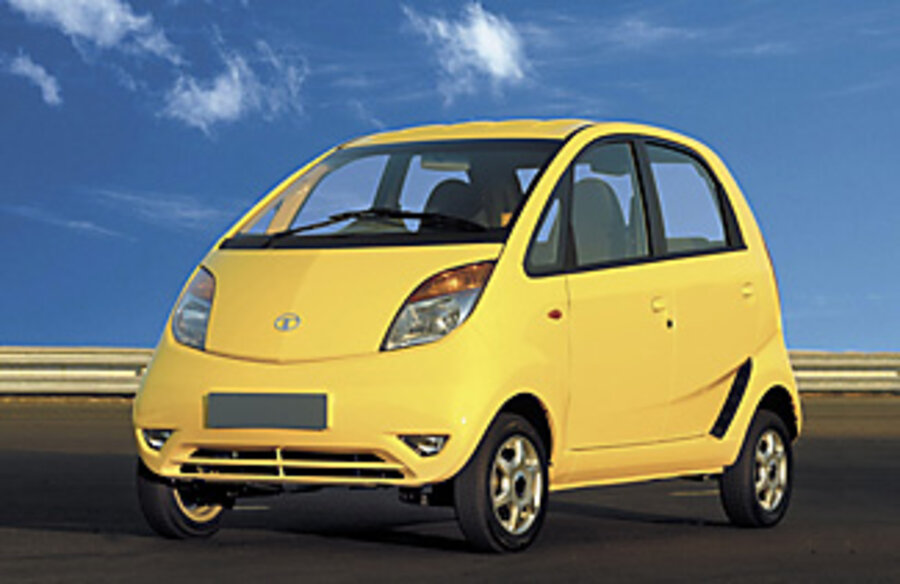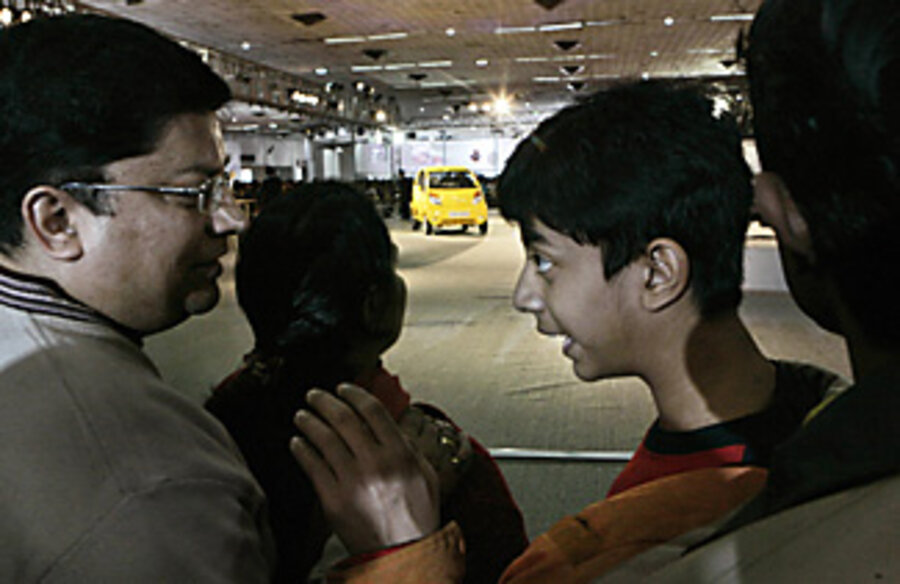Could the 'Nano' launch a revolution on India's roads?
Loading...
| New Delhi
At this week's Indian Auto Expo, the Tata Nano was greeted like a rock star.
Boys elbowed aside mothers and old men, drawing their cellphone cameras as though they had spotted Britney Spears, rather than the toaster on training wheels that the Nano more nearly resembles.
"It is a revolution," one said. "It is a real achievement," added another. To all, it was proof in gleaming steel that India's engineers could do what was thought impossible: design a $2,500 car that does not require home assembly or a giant windup key.
Also amid the throng was Mohammed Yameen. Unlike the others, he had no designer zip-up sweater or polished shoes. He had a dirty chest-length beard, a blue jacket turned brown by dust, and is missing a few teeth. Yet he also had a smile that lasted minutes. In broken English, he exclaimed: "I want this car."
The miracle of the Nano is that, when it becomes available to the public this autumn, he might be able to have it.
In a country still emerging from the notion of caste, where status is keenly felt and now often defined by one's possessions, the car has become one of the ultimate measuring sticks dividing the haves from the have-nots. The Nano suggests that might no longer be the case.
"It is a giant symbol," says Dipankar Gupta, a sociologist at Jawaharlal Nehru University here. "The wannabe motorcar owners have become gotta-be motorcar owners."
Is it safe? Compared with a Volvo S80, probably not. Is it reliable? Who knows, but it probably won't take any J.D. Power awards from Honda. Yet for tens of millions of Indians, the question is: "Is it better than the scooter that I have had for eight years and fixed so many times that I am now using spare parts from my ceiling fan to hold it together?"
The answer, it would seem, is a categorical "Yes."
Indian roads are circuses of elephants, death-defying traffic maneuvers, and attempts to wedge as many cars across a three-lane road as Newtonian physics will permit. At the center of this carnival is the consummate Cirque du Soleil act: a family of four on a scooter. As Tata's chairman, Ratan Tata, pointed out while unveiling the Nano, it is a ubiquitous sight: a young child standing in the footwell holding the handlebars, a father driving, and a mother behind (riding sidesaddle in her flowing sari, of course), holding an infant.
By this measure, the Nano could be a quantum leap forward in safety and reliability. Despite the much touted economic boom, only 0.8 percent of Indians own a car. And of all the vehicles sold in India from April to November of last year, 77 percent were two-wheelers – motorcycles, mopeds, or scooters.
Mr. Yameen says he came to the Auto Expo on a two-wheeler, and as he looks at the Nano, he says, breathlessly wide-eyed: "Very beautiful."
Even among those more well heeled than Yameen, the Nano draws raves.
"This is beyond expectation. It is going to make a revolution," says Pratishtha Dipathi, a well-dressed young woman.
Economists, however, question whether such a car can be profitable with such low profit margins: The day Tata unveiled the Nano, for example, its stock fell 6 percent.
In principle, though, Mr. Tata is attempting to do something akin to what Henry Ford did with his Model T. Rather than waiting for more of the population to rise economically to the point where they can buy a car, he has used his company's engineering know-how to reinvent what a car can be. He hopes to turn a profit by sheer volume, tapping into those untapped, poorer reaches of the Indian market.
It is a quintessentially Indian idea. For decades, Indian technology has been focused more on practicality than pomp, hoping its use will help the country's poor. The country's space program, for example, has long concerned itself only with helping farmers and schools through weather and communications satellites.
Now, the country has a car to carry on the tradition, and its people below the famous-but-still-small upper-middle class are cheering. Says Professor Gupta: "These are the people who are really excited by it."






